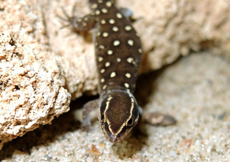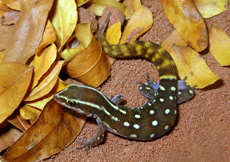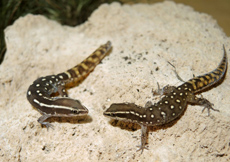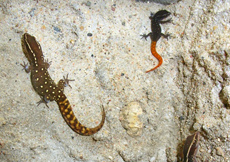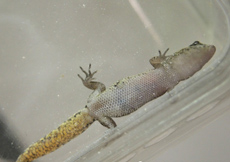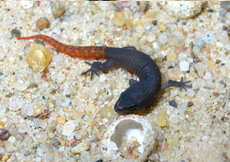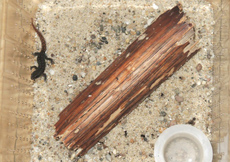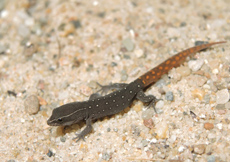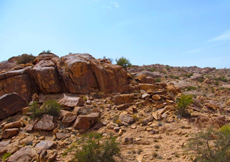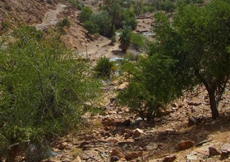Saurodactylus brosseti
(BONS & PASTEUR, 1957)
Distribution:
Saurodactylus brosseti is endemic in Morocco. The main distribution area is located west of the Great Atlas Mountains.
Description:
Saurodactylus brosseti was described in 1957 by Bons & PASTEUR as Saurodactylus mauritanicus brosseti. They were named after the Ornithologist and mammal watcher "A. Brosset", who collected the animals for them. Bons & GENIEZ raised the subspecies in 1997 due to differing characteristics in the species status. Furthermore GAMBLE ET AL. (2008) presented the genus together with the Neotropical Sphaerodactylini in the subfamily Sphaerodactylinae (Family: Sphaerodactylidae). MODERATO & JAMES HARRIS (2008 ) consolidated thier position in the family Sphaerodactylidae.
Saurodactylus brosseti is referred to in German as the Moroccan lizard gecko, whereas in English it is referred to as the Morocco lizard-fingered gecko. This species has a maximum snout-vent length of 31 mm and a total length of 67.5 mm (Schleich et al. , 1996). The females are slightly larger than males. The latter, as adult animals, can easily be told apart from females by their thickened tail base and collection of shiny scales ventrally between the hind legs. In terms of color, there are no differences sexually. The color intensity varies depending on the discovery site and populations. Their basic color ranges from beige to dark brown. Dorsally they have small to large heavily contrasted dashes, which later fade to white spots, most of which are arranged in two longitudinal rows. The dorsal scalation consists of small, flat, non-overlapping scales. Located laterally on both sides of their head is a light stripe from the tip of the snout to the neck . The tail coloration is yellow to orange, with scattered dark spots, which are united to the caudal tip into stripes. Ventrally, white- gray scales are large and overlapping. Saurodactylus brosseti has no adhesive discs on their toes, as this would prevent the effective locomotion on sand and digging. The pupils are slit shaped, which identifies them as crepuscular and nocturnal.
Juveniles are dark brown to black and have a red tail. Within three months, they begin to change color.
Habitat:
The climate, west of the Great Atlas Mountains is Mediterranean, with daily average temperatures in summer to 27°C (80.6°F) and to 20°C (68°F) in winter (Climate Chart Agadir, Morocco). The nightly temperatures in Summer, fall on average to 17°C (62.6°F) and in winter to 7°C (44.6°F). Daily temperatures of over 40°C (104°F) are not uncommon, the humidity, by the sea is about 50%, from sunset this increases to 96% ( MEEK, 2008). In order to tolerate these extreme and deadly temperatures for such a small gecko, they spend the day out of the way under stones and boulders, but can even be located amongst roots and in Opuntia plantations. In suitable hiding locations the animals are able to survive long periods of drought and extreme heat for several months (www.maroccoherps.com). In their micro habitat, despite high heat temperatures of around 28°C (82.4°F), the measured body temperature in Saurodactylus brosseti ranges between 25.7-28.5°C (78.3-83.3°F) during the day (MEKK , 2008). Apart from the lower temperature, the humidity in the micro habitat is on average 78% higher than outside of it on a daily basis (MEKK , 2008).
Once the sun has set, the animals are active and prey on small insects and arachnids (Schleich et al. , 1996). Their predators are scorpions and snakes, such as Malpolon monspessulanus and Macroprotodon cucullatus (Schleich et al. , 1996).
Husbandry and Breeding:
In relation to their size, Saurodactylus brosseti is an aggressive predator (www.maroccoherps.com), this applies not only to feeder insects, but also towards each other. This species should therefore, despite many claims that group housing is possible, only be kept in pairs. There has already been several reports made of biting with serious injuries between the females and males. In a paired housing, the animals mostly harmonize well together. For a pair, a terrarium with an edge length of 30 cm is recommended. In order to increase their radius of action, one should decorate the side walls with a rock like structure made of tile adhesive or the like. The geckos can then also frequently be observed when climbing. The substrate consists of sand, on this flat stones and pieces of bark should be stacked to allow the animals to hide. The stones should be firmly anchored to prevent animals from being destroyed while mining. When planting suitable small Euphorbiaceae, Sedums, or small, creeping Caralluma species have proven to be undemanding plants. Every 2-3 days, one side of the terrarium should be misted to increase the humidity. The geckos will lick the drops of water, however a small bowl of fresh water should always be made available. The terrarium lighting should be chosen so that temperatures of just over 30°C (86°F) can be achieved. A compact light with low UV output (Narva BioVital) in combination with a T5 tube and a small halogen spotlight has proven to suit this requirement just fine. At night the temperature drops to room temperature (about 22-24°C / 71.6-75.2°F). In Summer the lights are on for 12 hours daily and reduced to 8 hours daily in winter, or completely off at too high temperatures. In the latter case, the room should have at least a window or be lighted by further terrariums, so the geckos are still exposed to a day-night rhythm. In winter, temperatures during the day are kept just over 20°C (68°F) and fall at night to 16°C (60.8°F), temperatures well below 10°C (50°F) are also tolerated. Once the temperature and illumination time are raised in the spring, the geckos begin mating. Provided they have been supplied during the winter phase sparsely once a week with 1-2 food animals per animal, their appetite will now also increase and feeding twice a week with 3-4 prey items per gecko can be resumed. Feeder insects, in the appropriate size (crickets, firebrat , Drosophila , aphids, bean beetles , woodlice) should be offered varyingly. The size of the feeder insects should not exceed the width of the gecko's mouth! The food animals are alternately dusted with a mineral supplement with and without a preparation of vitamin D3. From the beginning of the reproductive females should be supplied with a bowl of calcium, such as crushed egg shell. Three weeks after mating the female buries a single egg with a size of 8x6 mm. The eggs were incubated both successfully in the terrarium, as well as the incubator. If you leave them in the terrarium, the substrate must never be dampened too much, as withering away of the unhatched offspring would be the result. The hatchlings are not eaten by the parents, so co-housing (in captivity) with the parents is possible. If the eggs are to be removed for better control outside of the terrarium, the sand may carefully be browsed with a pair of tweezers or the like for the eggs. The eggs can be transferred via a spoon to a small container filled with a shallow layer of dry sand. Turning the eggs had no effect on the hatching rate. If the humidity in the incubator does not fall below 40%, the box does not need to be re-moistened. The incubation time is about 90 days, if the incubation temperature is kept between 26-28°C (78.8-82.4°F) daily, with nightly reduction to room temperature. The young Saurodactylus brosseti emerge with a total length of 32-34 mm. Larger hatchlings can be reared together with smaller, but single rearing is preferable. The young may be raised in small (breathable) containers, with a 2 cm thick layer of sand. A small bowl of water and a piece of bark as a hiding place are sufficient. Keeping rearing containers in a warm place (example: on the lighting of larger terrariums ) so that daytime temperatures rise to about 26-30°C (78.8-86-°F), can be dispensed without actually lighting the actual containers. Every two days, a small corner of the box should be misted. If the water does not dry within a day or fog forms in the container (or wood molds), the spraying must be drastically reduced! Also every two days the young should be fed with 3-4 prey items in a suitable size. Supplementation of feeder insects is handled the same as the adults. After about three months the young slowly lose their youthful coloration. If biting takes place, the juveniles must be separated! The sexes can unfortunately not be determined until very late. At about a year the thickened tail base of the males can be observed. If you have the opportunity to compare several animals, such an issue arises far less.
If one wishes to keep a drier terrarium of dwarf geckos I can highly recommended Saurodactylus brosseti. The geckos show no shyness, but instead are small aggressive predators. Through threats and tail wagging they defend their territory, even against you, their behavior is similar to that of Leopard Geckos . They are easy to maintain (and very attractive) with some experience and a good live food source.
Literature:
- BONS, J., & PASTEUR, G. 1957: Nouvelles remarques sur les saurodactyles, avec description de Saurodactylus mauritanicus brosseti n. subsp. Bulletin de la Société des Sciences Naturelles et Physiques du Maroc, 37:175-195.
- BONS, J. & GENIEZ, P. 1996: Amphibiens et Reptiles du Maroc (Sahara Occidental compris). Atlas biogéographique. Asociación Herpetológica Española. Barcelona. 319 pp.
- GAMBLE, T., BAUER, A. M., GREENBAUM, E. & JACKMAN, T.R. 2008: Evidence for Gondwanan vicariance in an ancient clade of gecko lizards. Journal of Biogeography, 35: 88–104.
- SCHLEICH, H.H., KÄSTLE, W. & Kabisch, K. 1996: Amphibians and Reptiles of North Africa. Biology, Systematics, Field Guide. Koeltz Scientific Books. 630 pp.
- RATO, C. & JAMES HARRIS, D. 2008: Genetic variation within Saurodactylus and its phylogenetic relationships within the Gekkonoidea estimated from mitochondrial and nuclear DNA sequences. Amphibia-Reptilia 29 (1): 25-34.
- MEEK, R. 2008: Retreat site characteristics and body temperatures of Saurodactylus brosseti Bons & Pasteur, 1957 (Sauria : Sphaerodactylidae) in Morocco. Bull. Soc. Herp. Fr. (2008) 128 : 41-48.
- www.maroccoherps.com: Amphibians & Reptiles of Morocco and Western Sahara. Zugriff im Juli 2013.
